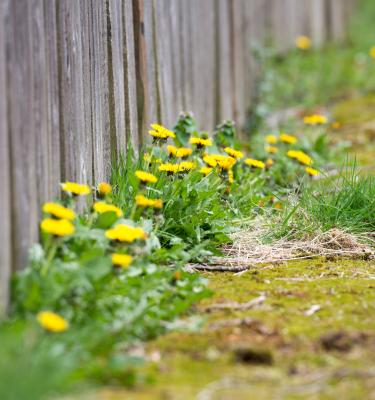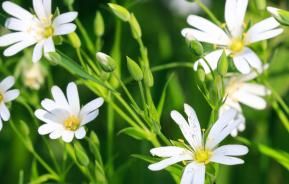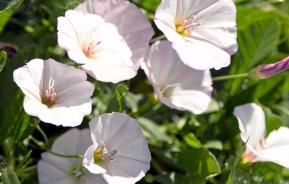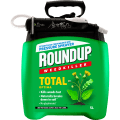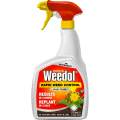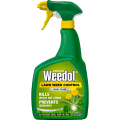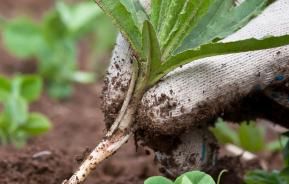What’s a weed?
Knowing when to clear weeds may have made you weary but it’s quite simple really. A weed is just a wild plant that is growing where it is not wanted, but you get to choose where you do and don’t want them in your garden. For instance, a weed poking through your patio or popping up within your borders may be irksome while weeds in an unused corner of the lawn can be left to grow happily.

The main reason people pull weeds is because they think they’re unsightly, but many weeds can actually be quite pretty, like vibrant dandelions, bird’s-foot trefoil or delicate Aquilegia. The only reason to really remedy your garden weed-free is if they’re competing with plants that you do really enjoy for light, moisture, nutrients or space.
Methods to manage
There are three ways of clearing weeds. First is non-chemical and involves hoeing, digging or pulling weeds out by hand. You could also lay a thick black polythene sheet over a patch of ground, weigh it down and leave it for several months which will stop weeds penetrating the surface, whilst preventing access to water and light so they die.
The second is organic chemical weedkiller which is more natural as it comes from a plant extract, such as Roundup with no glyphosate, which breaks down naturally in the soil. It tackles weeds like groundsel, annual meadow grass, mayweeds, clover and chickweed.
With very persistent, heavy duty weeds like nettles, brambles and doc leaves for those who find it too difficult to control by hand, you have an option to use a harder weedkiller such as Roundup with glyphosate, which will do the job.
Where to care
If you prefer to weed by hand as a method of control but also for the workout, it is like the cross-trainer—good for the garden and the body.
Annuals are the weeds that have a year life cycle and then seed for the next season, such as chickweed, which you may spot in your beds and borders. To remove these, work the soil around the weed with a hoe and remove by hand, try not to work the soil too deeply as un-germinated seeds may make their way up to the top of the soil.
On the other hand, dandelions and other perennials have a longer life cycle and return year after year because the root stays intact underground when the foliage dies back so removing the whole weed root is important.
Unwanted plants within your borders can be removed using your hands and garden tools, but if chemical methods are used on those such as bindweed, you’ll need careful, direct application of herbicides as they can become intertwined with shrubs which you won’t want to harm.
Weeds usually appear in paths and on hard surfaces as a result of seeds blowing into the cracks. In addition, moss, algae and lichens grow in damp and sheltered conditions, and can even add a mature and dated appearance to the garden.
However, if your vision is that of a clean and tidy patio or if they are causing a slip-hazard, you can regulate weeds on patios by using Roundup® NL Weed Control Ready to Use.
Suitable for use on gravel paths, around ornamental plants and trees, as well as patio areas, this handy spray has you covered. Just rotate the nozzle and directly spray the weed evenly, ensuring the leaves are covered. This product has fast results, with visible effects after just one hour.
My top tip is to be mindful when using products. Do not spray when it’s wet as there will be run off, or when it’s windy and can be spread. Over spraying isn’t necessary either, follow the instructions on the packet closely for the best results.
Bee kind
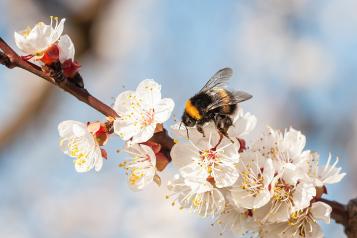
When getting to work in the garden, always remember to be kind to yourself and to the visiting wildlife. This means you need to stay safe with protective clothing and gloves, as some weeds may have thistles, and you also need to be mindful of how changes to your garden may affect the wildlife too.
Timing when you decide to remove weeds is important because some of our pollinator friends rely on the flowers on weeds for food. If your garden has dandelions growing, you may spot solitary bees visiting for the nectar and pollen. One option is to leave them those that are not invading your space to flower, if you can, then deadhead before they seed and spread to keep them under control.
If you choose to weed the majority of your garden, why not leave just an unobtrusive and weed-friendly corner in your garden as a welcome place for bees. This can look really effective when you pepper in some wildflowers and tall grasses.
Coming up against weeds needn’t be a worry, change your tactics to cater for all needs and you will have a balance between weed-free and wildlife-friendly in no time.
